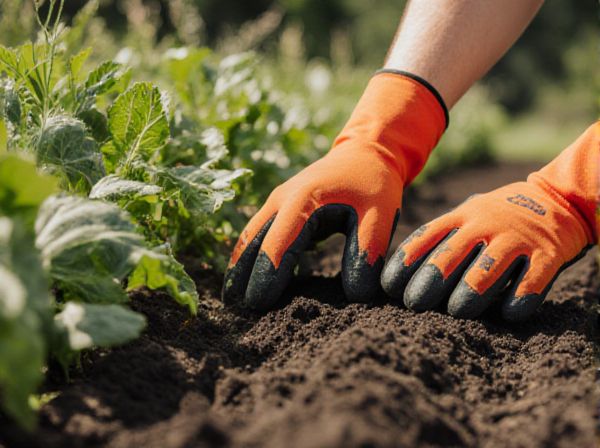
Crop rotation vs monoculture planting Illustration
Crop rotation improves soil health by alternating different crops, reducing pest buildup and enhancing nutrient availability, while monoculture planting depletes soil nutrients and increases vulnerability to pests and diseases. Rotating crops promotes biodiversity and sustainable farming by breaking pest and disease cycles that thrive in continuous monoculture systems. Sustainable crop rotation practices result in higher yields and long-term soil fertility compared to the limited resilience of monoculture planting.
Table of Comparison
| Feature | Crop Rotation | Monoculture Planting |
|---|---|---|
| Definition | Growing different crops sequentially on the same land | Growing the same crop repeatedly on the same land |
| Soil Health | Improves soil fertility and structure | Leads to soil nutrient depletion |
| Pest and Disease Control | Reduces pest buildup and disease risk naturally | Increases vulnerability to pests and diseases |
| Biodiversity | Enhances biodiversity and ecosystem resilience | Reduces biodiversity, disrupting ecosystems |
| Yield Stability | Promotes sustainable, stable yields over time | Yields may decline due to soil degradation |
| Organic Farming Suitability | Highly compatible with organic principles | Challenges organic certification due to chemical use |
Understanding Organic Crop Rotation
Organic crop rotation enhances soil fertility by alternating different plant families, reducing pest and disease cycles common in monoculture planting. Using legumes in rotation boosts nitrogen levels naturally, minimizing the need for synthetic fertilizers. This practice supports biodiversity and improves overall ecosystem resilience, making it a cornerstone of sustainable organic farming.
What Is Monoculture Planting?
Monoculture planting refers to the agricultural practice of growing a single crop species over a large area continuously. This method simplifies planting and harvesting but often leads to soil nutrient depletion and increased vulnerability to pests and diseases. In contrast, crop rotation involves alternating different crops on the same land to improve soil health and reduce pest outbreaks.
Benefits of Crop Rotation in Organic Gardening
Crop rotation in organic gardening enhances soil fertility by naturally replenishing nutrients and reducing soil depletion, unlike monoculture planting which exhausts the soil. This practice disrupts pest and disease cycles, minimizing the need for chemical interventions and promoting healthier plant growth. Increased biodiversity from rotating crops also improves soil structure and water retention, boosting overall garden productivity and sustainability.
Risks and Drawbacks of Monoculture
Monoculture planting increases the risk of pest infestations and disease outbreaks due to the lack of biodiversity, which diminishes natural pest control mechanisms. Soil degradation and nutrient depletion occur rapidly, leading to reduced soil fertility and increased reliance on synthetic fertilizers. The system's vulnerability to environmental stressors results in lower resilience and higher potential for crop failure compared to diversified crop rotation.
Soil Health: Rotation vs Monoculture
Crop rotation enhances soil health by preventing nutrient depletion and reducing pest buildup, promoting biodiversity and improving soil structure. Monoculture planting often leads to soil degradation, increased erosion, and a decline in beneficial microorganisms due to repetitive planting of the same crop. Implementing diverse crop rotations supports sustainable nutrient cycling and maintains long-term soil fertility.
Pest and Disease Management Strategies
Crop rotation enhances pest and disease management by disrupting pest life cycles and reducing pathogen buildup in soil, leading to healthier organic crops. Monoculture planting increases vulnerability to pests and diseases due to genetic uniformity, often necessitating more intensive organic interventions. Implementing diverse crop rotations promotes natural pest predators and soil biodiversity, which strengthens plant resilience and reduces reliance on organic pesticides.
Crop Diversity for Sustainable Yields
Crop rotation enhances soil fertility and disrupts pest cycles by alternating different crops, promoting crop diversity vital for sustainable yields. Monoculture planting depletes soil nutrients and increases vulnerability to diseases, reducing long-term productivity. Implementing diverse crop rotations improves ecosystem resilience, maintains soil health, and supports consistent organic farming outputs.
Environmental Impact Comparison
Crop rotation enhances soil health by increasing biodiversity and reducing pest cycles, leading to lower chemical fertilizer and pesticide use compared to monoculture planting. Monoculture often causes soil degradation, nutrient depletion, and higher vulnerability to pests, resulting in increased environmental pollution. Implementing crop rotation supports sustainable agriculture by improving carbon sequestration and minimizing runoff, thereby protecting ecosystems and biodiversity.
Practical Tips for Crop Rotation in Home Gardens
Crop rotation in home gardens improves soil health by alternating nutrient-demanding plants such as tomatoes with nitrogen-fixing legumes like beans, reducing pest buildup and disease risk associated with monoculture planting. Practical tips include dividing the garden into sections and rotating plant families each season, ensuring root depth variation to optimize nutrient use and prevent soil depletion. Incorporate cover crops such as clover or rye in off-seasons to enhance organic matter and maintain soil structure for sustainable organic gardening.
Choosing the Best Planting Method for Your Organic Garden
Crop rotation enhances soil fertility by alternating nutrient-depleting and nitrogen-fixing plants, reducing pests and diseases without synthetic inputs. Monoculture planting simplifies management but risks soil degradation and increased pest vulnerability in organic gardens. Selecting crop rotation fosters a sustainable ecosystem, improving long-term yield and soil health crucial for organic cultivation.
Crop rotation vs monoculture planting Infographic

 gardendif.com
gardendif.com